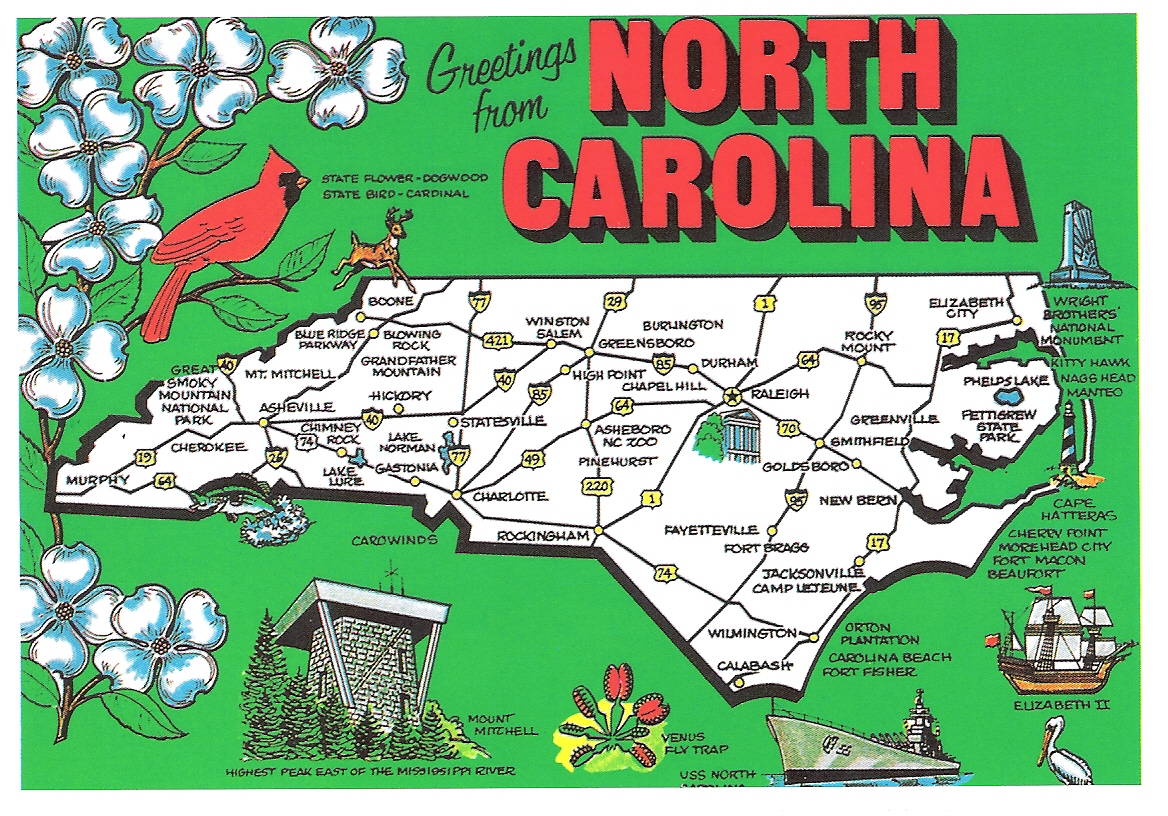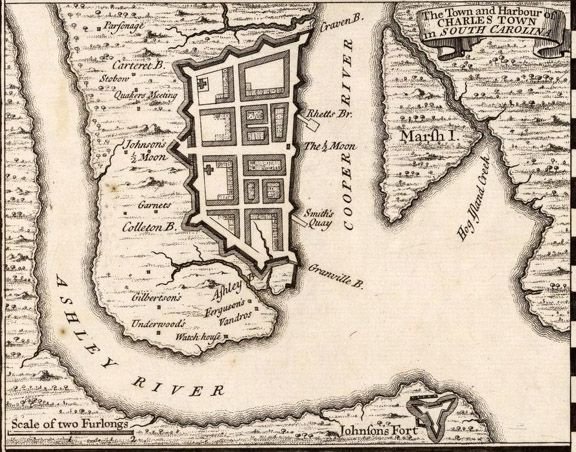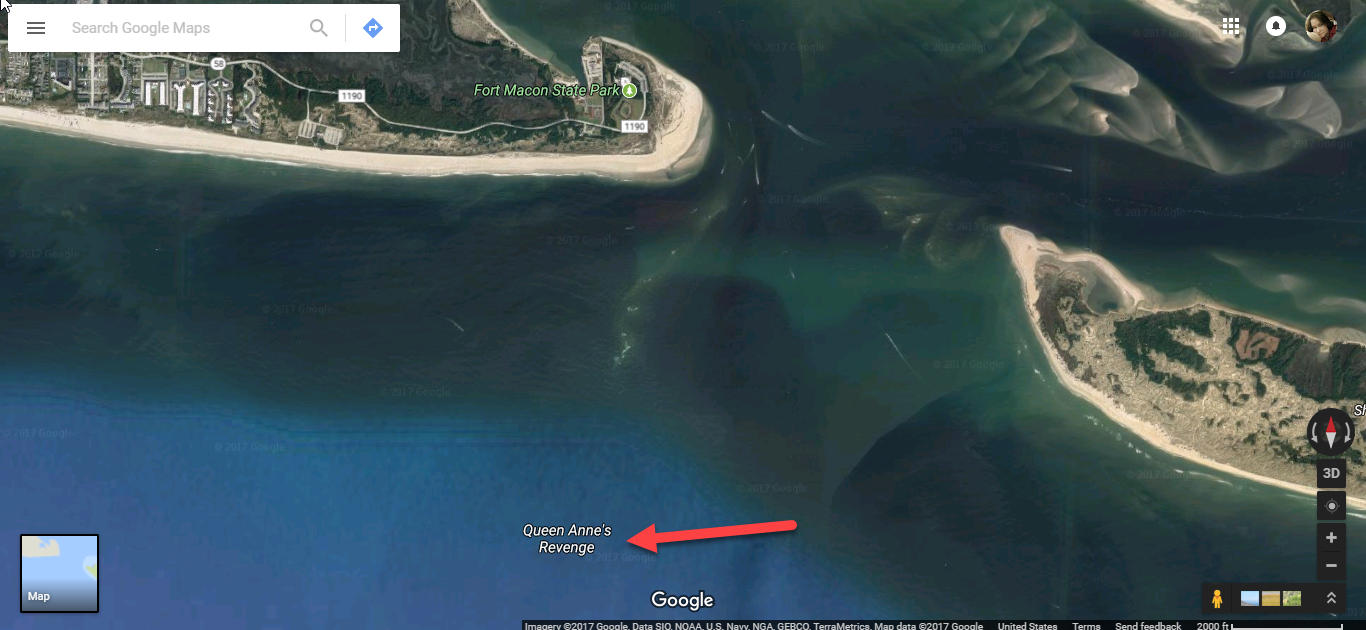When I was in the 4th grade MANY moons ago, we studied North Carolina history. I assume this is or was the norm across the U.S. to study one's own state history at some point in school.
My mother and her side of the family have deep roots in North Carolina, so I was raised with a love for the Old North State. As a result, learning the history that year in school has really stayed with me.

I can rattle off the state bird, tree, mineral, dog, flower, and more. Being a native, there are a lot of things I can tell you about this great place, but one thing stuck with me more than the rest when I moved away in 2004 and lived in Las Vegas, Nevada for 4.5 years...PIRATES!
North Carolina was the home port of one of the worst pirates to sail the seven seas. Edward Teach, or Blackbeard as he is better known, called the waters off North Carolina his home. In fact, the coast of North Carolina was frequented by pirates because of its large ports like Wilmington, and its unique barrier islands or Outer Banks.
.svg.png)
Blackbeard's flag.
The many river mouths and jagged edges made for a maze where it was easy to lose unwanted attention. While piracy is criminal at its root, these fellows (and a few ladies too) are so fascinating to me.

Map of the Outer Banks of North Carolina.
With reckless abandon they took to the seas to plunder what they could. Pirates were not particular about who could be included in their band. Black, white, it didn't matter. An able body was of utmost importance and fortunes could be made in open water for men who otherwise would live in poverty.
The Golden Age of Piracy
The Golden Age of Piracy spanned from the mid 1600's until the 1730's. It is divided into three periods when piracy experienced three separate rises:
- Buccaneering (1650-1680) - This period was characterized by mostly French pirates based in Tortuga and Jamaica who concentrated on Spanish shipping lanes in the Caribbean.
- Pirate Round (1690's) - These pirates were the most successful. Based in Madagascar, they sailed around Africa and into the Indian Ocean and Red Sea where they were able to plunder the exotic goods carried by the ships of the East Indies. Without colonial jurisdiction in the area, Pirate Rounders continued on even when piracy was in decline elsewhere.
- Post-Spanish Succession (1716-1726) - Sailors left unemployed by the War of the Spanish Succession turned to piracy.
In this final period is where we find Captain Teach, a.k.a Blackbeard.
The Dread Pirate Blackbeard

Surprisingly, not a lot is known about Blackbeard. His reign as one of the most feared pirates of all time was a short 2 years long. What we know of him during this time is mostly pulled from old books and surviving records.
Some things are still uncertain like when he was born and his actual surname. It is believed he was born around 1680. His surname has been recorded as Thatch, Thach, Thache, Thack, Tack, Thatche, and Theach. Who knows?
.jpg)
What brought this English sailor to the Caribbean is unknown. What is known is that Edward Teach became a pirate and joined the crew of Benjamin Hornigold in 1716 based in the Bahamas.
Edward spend the first year or so of his piratical career gaining his sea legs and becoming a first-time captain under Hornigold and an injured Stede Bonnet. Assembling a flotilla, they took ships from Havana to North Carolina.
Becoming Blackbeard and Acquiring a Flagship
By November of 1717, Teach had become a pirate in his own right as captain of the Revenge, Stede Bonnet's old ship. Blackbeard and crew captured a French slave frigate, La Concorde, near the Grenadines. Blackbeard sailed the ship to Bequia to be repaired and retrofitted for pirating.
Illustration of QAR published in 1736.
With 40 cannons and a new name, the Queen Anne's Revenge was born. Slave ships were known for their speed and durability thus making them the perfect ships for pirating.
Blackbeard and Slaves
While Blackbeard most likely left the slaves from the La Concorde in Bequia where they were recaptured, he was known to have up to 40% Africans as members of his crew...FREED slaves. A dichotomy existed between pirates and the colonies regarding slavery.
The Height of Blackbeard's Career
With his new flagship, the Queen Anne's Revenge, it is likely that Blackbeard returned the Revenge to a now recovered, Stede Bonnet. Many accounts have them working as partners for a time.
Portrait of a Pirate

A 1736 engraving that's been colorized depicting Blackbeard.
During this time, the first reports roll in regarding the appearance of Blackbeard. He was a tall man with a long, black beard often separated into braids and tied with red ribbons.
He carried no less than three flintlock pistols into battle. He wore knee-high boots and dark clothing with a wide hat. He also wore a bright-colored coat made of velvet or silk in battle. He would stick lit, slow-burning matches beneath his hat to give a smokey and intimidating appearance.
All Bark and No Bite
Blackbeard used his horrible reputation and scary appearance as a means to preserve his prizes. He could often intimidate a captain into surrender without firing a single shot. After all, damaged ships and dead people were just something else to have to deal with and could mean less loot.
In December of 1717, Blackbeard captured a sloop called the Margaret under the command of Captain Henry Bostock. His crew locked up the captain and crew as they ransacked the ship for 8 hours, but returned them all unharmed to the ship and sent them on their way.
Blackbeard never killed or harmed anyone he held as prisoner.
The Pillaging Continues
A report from February 1718 documents Blackbeard and his flotilla sailing through the Leeward Islands. They sailed up the north side of Hispaniola. They captured and were joined by the Adventure and crew in lieu of fighting. In the Bay of Honduras, they added another ship and 4 sloops to the gang.
.jpg)
On April 9th, they took the Protestant Caesar, a ship that Stede Bonnet had failed to capture a month earlier. They sailed on in the direction of Grand Cayman capturing more ships along the way. Near Havana, they captured and added a Spanish ship to their fleet. On his way to Charleston, South Carolina, Blackbeard and crew claimed 3 more ships.
Commodore Blackbeard?
At the very apex of his career, Blackbeard bestowed upon himself the title of Commodore which infuriated the British Royal Navy. Blackbeard had established a small fleet wielding enough firepower to propose a challenge to the British Royal Navy. They feared that he might spearhead an attempt to establish a Commonwealth of pirates.
The Blockade of Charleston (Charles Towne)

In late May of 1718, Blackbeard and his allies blockaded Charleston, South Carolina in an attempt to acquire medical supplies and medicine. For a week, he and Stede Bonnet raided every vessel attempting to dock in Charleston. Finally, a ship of prominent Charlestonians arrived and they held the people ransom in exchange for the supplies which they finally received after some run around.
Upon receiving the supplies, Blackbeard released all of the citizens unharmed, but stripped of their valuables.
The King's Pardon and QAR Ran Aground in Beaufort Inlet
During the Blockade of Charleston, Blackbeard heard about the King's Pardon of 1718. Great Britain had assembled a flotilla of well-equipped ships under Woodes Rogers to rid the Caribbean of pirates once and for all.
Blackbeard sailed North to Beaufort Inlet, also known as Topsail Inlet in North Carolina. Sensing that his fleet was drawing too much attention, he intentionally ran the Queen Anne's Revenge aground. The proud flagship was destroyed.
Blackbeard intended to received the King's Pardon which was open to all pirates as long as they took it before September 5, 1718. This pardon offered immunity for any and all piratical crimes committed before January 5, 1718. This posed a problem since the Charleston Blockade occurred after that date; however, Blackbeard knew he could still be pardoned by a colonial authority.
He and Stede Bonnet sought out someone they could trust. They found that person in Charles Eden the governor of Bath, North Carolina and accepted a pardon in June of 1718. Blackbeard settled in Bath, but traveled between there and his Ocracoke Inlet hideout several times over the next few months.
Back A-Pirating
By the end of August, Blackbeard was back to pirating. The Governor of the Province of Pennsylvania issued a warrant for his arrest. This would be the beginning of the end for Blackbeard.
Alexander Spotswood, the governor of the Province of Virginia learned of Blackbeard's whereabouts. Although out of his jurisdiction, Spotswood circumnavigated the legal ramifications and put together a small crew to capture the pirate.
The Demise of Blackbeard - The Battle of Ocracoke Inlet
Lieutenant Robert Maynard of the British Royal Navy took command of 2 armed sloops and went after Blackbeard on November 17, 1718. On the evening of the 21st, Maynard found Blackbeard anchored on the inner side of Ocracoke Island.
Maynard opted to wait for daylight, but in the meantime blocked all traffic into the inlet so Teach could not be warned. He set 2 watchmen, one on each sloop.
Meanwhile, Blackbeard was entertaining on the other side of Ocracoke Island without the benefit of a lookout. He also was missing a good chunk of his crew who were ashore in Bath. It was reported that he had no more than 25 men, but he, himself boasted that he had 40 with him.

At daybreak, Maynard's 2 sloops entered the channel following a smaller boat which was spotted almost immediately by Blackbeard's ship, the Adventure. He cut his anchor line. The crew hoisted the sails and the Adventure moved to aim her guns at Maynard's sloops engaged in a slow, but steady approach.
Union Jacks unfurled on each sloop. The Adventure fired, and in a single volley took out a third of Maynard's crew. One sloop was done. The battle seemed to be going in Blackbeard's favor.
What happened next is unclear. Either one or all ships ran aground and a race ensued to see who could float first. Maynard had kept many of his men below decks and Teach watched as the gap between the two grew small. Grappling hooks from the Adventure pulled the two ships together, as grenades fashioned from shot and bottles ignited the deck.
When the smoke cleared, Teach boarded with his crew firing at Maynard and a small band at the stern of the remaining sloop. Teach was confident that his victory would be momentary when the remaining men burst from the hold.
Gobsmacked by the assault, Teach formed his men into 2 groups. Maynard and Teach fired their pistols at each other before tossing them aside. Blackbeard drew his cutlass and disarmed Maynard, breaking his sword. Maynard's men pushed the pirates backward toward the bow of the ship.
Maynard and Teach were now somewhat isolated, but surrounded by their men. Maynard drew a pistol to fire again, but Teach lunged to attack him first. He met the blade of one of Maynard's men slashing his throat.
The wound was bad enough that Maynard's men were able to finish him off. The remaining pirates surrendered without protest.
Upon inspection, Blackbeard was found to have been shot no less than 5 times and cut by sword no less than 20 times. His head was cut off and his body was thrown into the sea. Maynard mounted the head on the bowsprit of his ship as a warning to pirates.

That was the end of Blackbeard and piracy continued to decline thereafter.
The Wreck of the Queen Anne's Revenge Found!
The wreck of the Queen Anne's Revenge was found in 1996 about a mile from Fort Macon near Beaufort Inlet. The site wasn't immediately identified and was just a cluster of cannon and anchors.

The artifacts that were recovered were right for the time period and included a bronze bell dated 1705, a sounding weight, a blunderbuss barrel, and two cannonballs.
In 2004, the site was confirmed as the Queen Anne's Revenge identified by the previous artifacts, nine cannon, and two large anchors pulled from the site.
Check Out The Artifacts
I have a few pictures, but none of these are too great since there was some initial confusion regarding photography in the museum. I kind of had to go back and snap some photos quickly as a result instead of taking my time. Anyway...enjoy!
The two cannon on display along with various types of shot. Ba-boom!
The business end of the big one through the glass.
At the bottom is timber from the wreck that survived 350 years on the sea bottom. Also you can see ballast stones, a great model, and the area in red on the hull that was recovered.
The first of two bronze bells pulled from the wreck site marked 1705.
A display with many artifacts.
If you'd like to see more, be sure to visit the QAR website here - https://www.qaronline.org/
Did You Enjoy This Post?
Check out my visit to Fort Macon!
I hope you will consider giving me a follow so you don't miss the other posts from my recent vacation. I write about all kinds of things. Here's a sampling:
- My Help Comes From the Lord Wallpaper
- Why Didn't I Think of That!?! #1 - Art-O-Mat - The Ultimate Upcycle
- Learning WordPress with ProWebWriter - and ongoing series of tutorials
- Social Networks Paying or Trading in Crypto - A Steemit Un-Competition Overview
- Create Snazzy Title Graphics with Canva
- How to Back Up Your Steemit Articles
- Self-Publishing with ProWebWriter on a ZERO Budget - This is an ongoing series with currently 5 parts
- That Time in 2012 When I Saw UFO's!
- Where Are You Sleeping Tonight, Amelia? - I've been known to write a poem...
- Warm Summer South - ...or two








It is so sad when a pirate has better resolve than politicians.
Downvoting a post can decrease pending rewards and make it less visible. Common reasons:
Submit
Indeed...and 350 years ahead of our time.
Downvoting a post can decrease pending rewards and make it less visible. Common reasons:
Submit